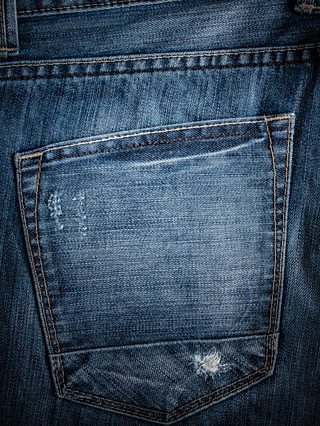Why are denim jeans still so popular?
Whether baggy, skinny, high-waisted or boot cut, denim jeans are a versatile garment that has enjoyed an iconic status since their creation more than 150 years ago.
This year the denim sector will be worth $105 billion, of which jeans will account for $64.5 billion. The US remains the country that spends the most on jeans, but the UK is no slouch with 70 million pairs sold here every year.
For Βι¶ΉΤΌΕΔ Radio 4's All Consuming, marketer and entrepreneur Charlotte Stavrou and science journalist Amit Katwala unravel the irresistible allure of jeans, looking at how they have been used as a symbol of freedom and rebellion across the world, from 1950s America through to Noughties Belarus. Here's what they discovered on their stone-washed journey...

Jeans were born in the USA
Legend has it that denim originated from the pretty French town of Nîmes (ie. 'de Nîmes') where a blue denim fabric was made. However, the origin story is actually tied to the country that made them famous, the US, with the production of denim there dating back 150 years.
The first jeans were made to be indestructible
Jeans were initially designed as hard-wearing clothes for prospectors during the California Gold Rush by a tailor called Jacob Davis. Davis was using a brown canvas fabric reinforced with rivets so that prospectors could fill their pockets with rocks and stones.
Davis knew his virtually indestructible pants were a winner but didn't have the money to take a patent out. He turned to the man who was supplying the fabric he was using, dry goods salesman Levi Strauss, whose name would become synonymous with the garment.
The patent was for the rivets and not the pants!
Strauss helped Davis secure a patent but it was for the rivets as opposed to the garment itself. This meant that between 1873 and 1890 no one was allowed to use rivets! "A lot of amazing denim details and designs happened in this magical period," says Mohsin Sajid, denim designer and fashion lecturer.
The next step for Davis and Strauss was to change the garment away from the brown cotton canvas to a more traditional workwear blue but keep things cheap. Their prayers were answered in 1883 when German scientist Adolf von Baeyer created synthetic indigo.

Blue jeans are an optical illusion
With the availability of cheap synthetic indigo, the recognisable blue denim was born. Only it's not all blue. "Look closer and you'll see it's a mixture of white and blue," says Amit, "a trick of the eye designed to cut costs."
"Instead of dyeing all the fabric blue," explains Mohsin, "they would die the warp yarns only, and then put the white weft through it. They would leave it in such a way that more of the warp yarns were outside than inside, giving the illusion of a blue fabric."
The fades are built-in
A by-product of using cheap dye is the way jean colour fades, and this would become a part of its allure as a fashion item. The fades are such a feature that there is even a competition held online for the best ones called the Indigo Invitational. Each competitor spends a year wearing the same raw denim (ie. not pre-faded) and lets their life and work create a unique signature fade on it.
Jeans came with a guarantee
The paper label that you often see stitched to the back of jeans represents the guarantee receipt that used to be kept in the back pocket. If the jeans ripped, you showed your guarantee to the vendor and could get a new pair straight away.
They went from workwear to leisurewear
From the 1880s to the Second World War, jeans became a universal workwear item. After the war, jeans became a ubiquitous symbol of Western youth culture, popularised by, among others, James Dean in Rebel Without a Cause and Marilyn Monroe in The Misfits.
Jeans went back to their roots in the 1980s
Hollywood stardust may have been sprinkled on them but by the 1980s jeans were fading as a style icon. Their stock plunged because America was seen as "the land of Mickey Mouse and Ronald Reagan" as advertising executive Sir John Hegarty puts it, and so lacked cool points.
Hegarty's company, BBH, won the Levi's account in 1982. For their first ad, they went back to the basics to produce a mini-epic with an industrial feel that focused on the iconography of the rivet. The next ad emphasised how jeans symbolised the free world, with a young boy smuggling a pair of jeans into Russia.
They were a revolutionary symbol
BBH's Russian ad resonated – art was imitating life. In Russia, jeans were seen as a symbol of the free world and – given that US-made jeans were outlawed – of rebellion.
Denim persisted as a symbol of rebellion after the fall of the Soviet Union. In Belarus, the 2006 the protests against the country’s authoritarian leader Alexander Lukashenko, were nicknamed 'The Jeans Revolution' after an opposition flag torn down by police was replaced by a denim shirt. To mark the symbolism, protestors cut up denim into ribbons, a powerful statement that still endures today.
They are a part of our culture
The most memorable of the BBH Levi's ad collection is from 1985. It saw model and musician Nick Kamen put rocks in a laundrette washing machine and undress to his boxer shorts in order to perform some DIY stonewashing/fading on his 501 jeans, as Marvin Gaye's Heard It Through the Grapevine played. Sales went berserk, with the ad pulled for a period because the manufacturers could not meet the demand.
A similar retro tone was set for subsequent ads, all of which helped Levi's reach their peak sales point of $7.1 billion in 1996.
"To be great, a brand must become a part of culture, just like any piece of creative work," says Sir John Hegarty. "If that piece of creative work becomes a part of culture, it becomes referenced and then it has added power."
Don't put your jeans in the freezer!
Speaking of culture, you may have heard that putting your jeans in the freezer when they start to smell is a way of killing the bacteria. Unfortunately, this is a myth. The bacteria are frozen temporarily, so when you put them back on, they start to grow again and make the jeans smell worse!
To find out more about Charlotte and Amit's adventures in the world of denim, just listen to the episode in full.
The information contained in this article was correct at the time of broadcast on 7 September, 2023.

More articles from Βι¶ΉΤΌΕΔ Radio 4
-
![]()
Why do we love playing board games so much?
Unpacking their appeal, from Snaks and Ladders to complex strategy games.
-
![]()
How did tea become the nation's favourite drink?
The contentious story of tea and its place in the British psyche.
-
![]()
Just how healthy are plant-based meat alternatives?
Looking into how good processed vegan, plant-based products are for us.
-
![]()
How did vaping get so popular?
Tracing the history and extraordinary growth of e-cigarettes.





